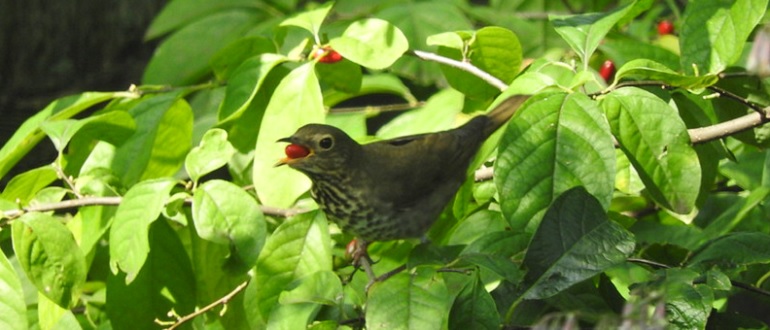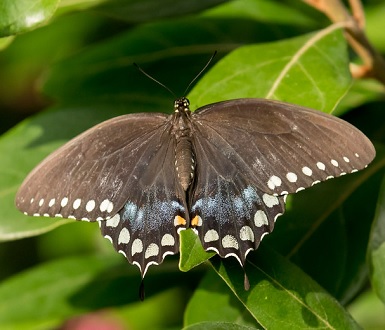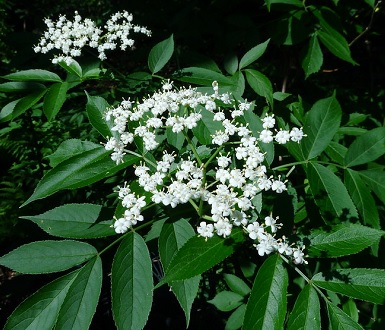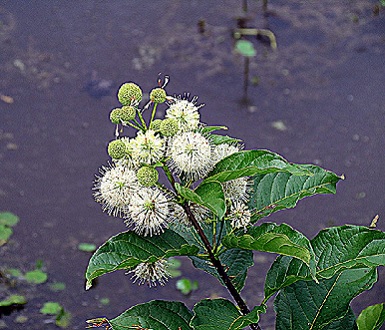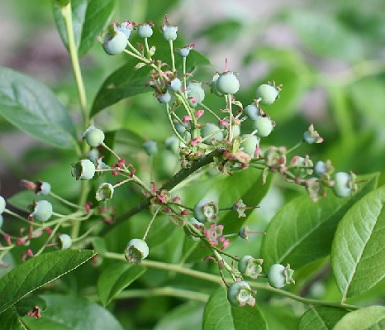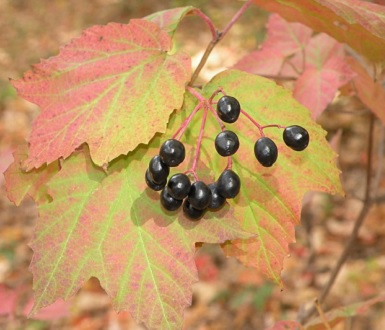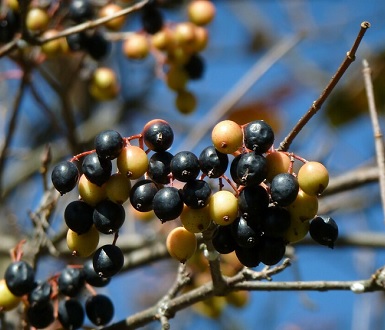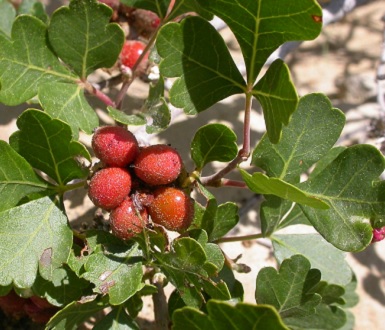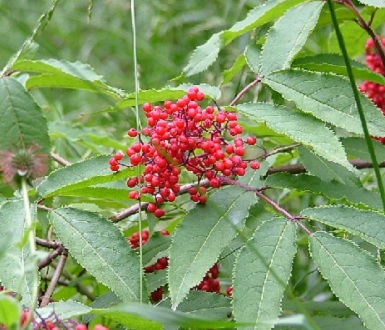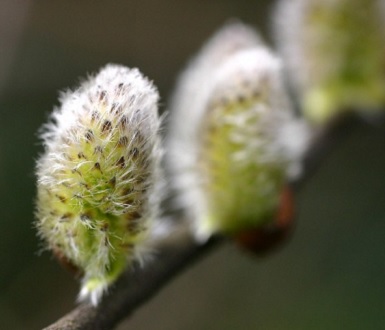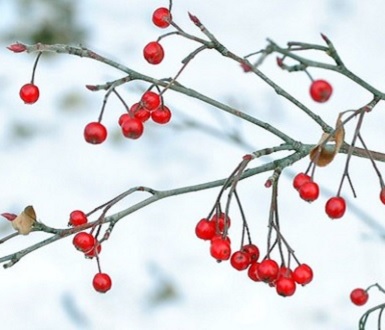GET TO KNOW
Our native shrubs
Two hundred years ago, the Rouge River watershed encompassed vibrant communities of beech-maple forests, hardwood swamps, and wet prairies. There were tall trees, tall grasses, and shrubs. In fact, there were a great many shrubs.
There were tall shrubs and short shrubs, sparse shrubs and dense shrubs. There were shrubs that grew individually and shrubs that grew in thickets. Together, the shrubs formed a rich, intermediate layer of vegetation.
NOTEWORTHY FACTS: In our contemporary urban / suburban landscapes, native shrubs are often forgotten. Instead, our suburban yards are bursting with the standard “go to” shrubs that hail from all parts of the globe. Many of these have proven to be invasive and damaging to our natural habitats. For example:
* Boxwood is native to Southern Europe and northern Africa.
* Forsythia is native to eastern Europe and Eurasia.
* Lilac is also native to eastern Europe and Eurasia.
* Barberry is native to mountain areas of Asia.
* Burning bush is native to eastern Asia.
* Multiflora rose is native to eastern Asia (China, Japan, Korea).
* Spiraea japonica, (the most commonly used spirea) is native to Japan.
Even hydrangea and azalea, which are native to the US, are not native to Michigan.
Occupying the space below tree canopies and above the grasses, the shrub layer offered a haven of food and shelter for wildlife. The shrubs provided bountiful offerings of strong branches, leaves, flowers, fruits, twigs, and even bark to meet the ever-changing needs of wildlife. They were year-round sources of food and places to rest, to hide from predators, to shelter from storms, and to raise the young.
The shrub layer was a busy place. White-tailed deer, foxes, raccoons, woodchucks, opossums, skunks, squirrels, chipmunks, mice, songbirds, ground birds, bees, beetles, flies, moths, and butterflies all found a home. Waterfowl, muskrats, and beavers slipped easily between the streams and shrubs while migrating birds stopped by to rest during their travels. Overall, life in the shrub lane was pretty good.
FEATURED NATIVE SHRUBS
A few of our most important shrubs for providing wildlife habitat include northern spicebush, American elderberry, buttonbush, smooth highbush blueberry, maple-leaf viburnum, nannyberry, fragrant sumac, red elderberry, native willows, and winterberry. (Note: the native willow Salix discolor (a.k.a. pussywillow) and winterberry were both featured in earlier articles.
Northern spicebush (Lindera benzoin)
A 6-12 ft, dioecious (separate male and female plants) shrub. Male plants have yellow, early spring flowers while female plants (if properly pollinated) grow nutritious, red, fall fruits. Fruits are persistent in that they hang on branches until eaten by wildlife. Early spring flowers provide pollen and nectar, and the leaves are a larval host for spicebush swallowtails, eastern tiger swallowtails, and Prometheus moths. Twigs, leaves, flowers, fruits, and seeds are all edible and, this shrub offers a bounty of culinary treats for both wildlife and people. Some people even indicate that crushed spicebush leaves are an effective mosquito repellent. If you have trouble establishing shrubs due to deer browsing, spicebush is a good choice as they tend to choose other leaves.
American elderberry (Sambucus canadensis)
This medium sized shrub (9ft-12ft) is a favorite of pollinators, birds, and grazing mammals. It grows well in partial shade with moist soil. When cooked, elderberry flowers and berries are edible and are used for jam, pies, and wine. However, raw fruits, flowers, leaves, and stems are mildly toxic to humans. Both male and female flowers grow on the same plant, but the berry yield will generally be greater with multiple shrubs. Like spicebush, deer tend to avoid this plant.
Buttonbush (Cephalanthus occidentalis)
This medium sized (6ft-12ft) shrub with showy white “pin cushion” looking flowers is a good alternative to the invasive butterfly bush for wet, swampy areas such as rain gardens. It is a superstar plant for pollinators and fruit loving birds, but the leaves are somewhat toxic to mammals (including dogs, cats, and people).
Highbush blueberry (Vaccinium corymbosum)
This is a large (15ft), native blueberry shrub and a wildlife superstar. This shrub attracts all types of birds, bees, and butterflies and is a larval host for some members of the elfin butterfly group. Additionally, the shrub provides excellent grazing for both large and small mammals.
Maple-leafed viburnum (Viburnum acerifolium)
This is a small (3ft – 6ft) shrub with maple looking leaves, spring white flower clusters, and persistent blue-black fall berries. It attracts birds, bees, and butterflies, and is a larval host to some moths and the Spring azure butterfly. It is drought tolerant and good for rain gardens.
Nannyberry (Viburnum lentago)
This large deciduous shrub (15ft -20 ft) has white flower clusters in spring and persistent, red autumn leaves, and blue-black berries in Fall / Winter. Berries are a favorite of many birds and mammals while leaves are larval host for several moths and the spring azure butterfly. Raw berries are generally not palatable, but they can be processed to make a variety of tasty jelly and butter type spreads. This shrub works well in urban environments (and large rain gardens) as a specimen plant or tall hedgerow.
Fragrant sumac (Rhus aromatica)
This is a non-toxic sumac (i.e. does not cause a skin rash) that grows 512ft. It is a dioecious, (separate male / female plants) shrub, and both male and female plants need to be present for berry production. Early spring flowers attract bees while persistent red fruits attract many birds. The shrub is known for its beautiful, red foliage in fall. It is the larval host plant for several moths and (in southern states) the red-banded hairstreak butterfly. This plant does spread by suckering, but it works in urban environments as a ground cover or hedgerow. It is drought and salt tolerant and can work in the upper regions of rain gardens.
Red elderberry (Sambuscus racemose)
This a medium sized, riparian shrub (8ft – 12ft) bears bright red berries in spring. The berries are an absolute favorite for fruit-eating birds. Early season berries, such as these, tend to have a high protein value to aid in the rapid growth of new fledglings. (In contrast, late season berries tend to have a fat content to supply extra energy for migrating birds and cold weather survival.) The spring flowers also attract hummingbirds and butterflies, and the leaves are a larval host for more than a dozen moths (including the lovely Virginia tiger moth). Note: While highly palatable to birds, the raw berries are somewhat toxic for people and dogs.
TAKE ACTION
Native plants are the foundation of a healthy ecosystem. Historically, shrubs played a major role in providing wildlife habitats within the Rouge River watershed. Today, as we work to preserve and protect our watershed, it is important to include native shrubs in landscape plans and restoration efforts.
Running through suburban Wayne and Oakland counties, less than 25% of the Rouge River watershed remains undeveloped. Natural areas with shrub communities only exist in small bits and pieces; and even in those spaces, a variety of invasive shrubs are threatening native vegetation.
It is up to all of us to preserve the biodiversity of our wildlife and the natural habitats they depend on. You can help by planting native shrubs wherever possible and by volunteering with FOTR at one of our many restoration events.
MAIN PHOTO CREDIT: Swainson’s thrush in Northern Spicebush (Lindera benzoin) – Brian Plunkett – CC-BY-2.0 – image cropped
